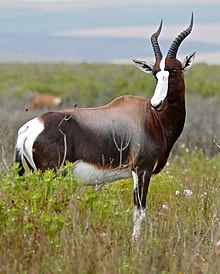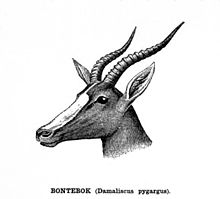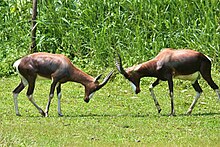Bontebok
| Bontebok | |
|---|---|

| |
| Bontebok in Bontebok National Park, South Africa. | |
Conservation status
| |
| Scientific classification | |
| Kingdom: | Animalia |
| Phylum: | Chordata |
| Class: | Mammalia |
| Order: | Artiodactyla |
| Family: | Bovidae |
| Subfamily: | Alcelaphinae |
| Genus: | Damaliscus |
| Species: | D. pygargus
|
| Binomial name | |
| Damaliscus pygargus (Pallas, 1767)
| |
| Subspecies | |
| |
The bontebok is a subspecies of Damaliscus pygargus, an antelope found in South Africa, Lesotho and Namibia. D. pygargus has two subspecies; the bontebok (Damaliscus pygargus pygargus),[2] occurring naturally in the Fynbos and Renosterveld areas of the Western Cape, and the blesbok (Damaliscus pygargus phillipsi) occurring in the Highveld.
The bontebok is related to the common tsessebe.
Description[]

The bontebok is a tall, medium-sized antelope. They typically stand 80 to 100 cm (31 to 39 in) high at the shoulder and measure 120 to 210 cm (47 to 83 in) along the head and body. The tail can range from 30 to 60 cm (12 to 24 in). Body mass can vary from 50 to 155 kg (110 to 342 lb). Males are slightly larger and noticeably heavier than females.[3] The bontebok is a chocolate brown colour, with a white underside and a white stripe from the forehead to the tip of the nose, although there is a brown stripe across the white near the eyes in most blesbok. The bontebok also has a distinctive white patch around its tail (hence the Latin name), while this patch is light brown/tan in the blesbok. The horns of the bontebok are lyre-shaped and clearly ringed. They are found in both sexes and can reach a length of half a metre.
Habitat[]
Blesbok live in the Highveld, where they eat short grasses, while bontebok are restricted to the coastal Fynbos and the Renosterveld.[4] They are diurnal, though they rest during the heat of the day. Herds contain only males, only females, or are mixed, and do not exceed 40 animals for bonteboks or 70 for blesboks.

Behavior[]

Bontebok are not good jumpers, but they are very good at crawling under things. Mature males form territories and face down other males in displays and occasionally fight them.
Threats[]
Bontebok were once extensively killed as pests, and were reduced to a wild population of just 17 animals, but the species has since recovered,thanks to the help from Deneys Reitz, under orders from the minister of lands for South Africa, Mr. Piet Grobler, who recognised the need to provide a sanctuary to prevent extinction. Following a survey of the area where the Bontebok were located, around 70 were counted, and of these, 17 were successfully corralled into their new enclosure,thereby saving them from extinction. The recovery is all thanks to a coalition between the South African Government and a group of hunting outfitters in South Africa which not only funded conservation but also provided the needed land. Bontebok are extinct in their natural habitat, but they have increased in population to the point where they are now very abundant and avidly farmed, because they are popular quarry for hunters and are easy to sustain.
In culture[]
The bontebok is the provincial animal of Western Cape.[5]
References[]
![]() Data related to Damaliscus pygargus at Wikispecies
Data related to Damaliscus pygargus at Wikispecies
- ^ Dalton, D.; Birss, C.; Cowell, C.; Gaylard, A.; Kotze, A.; Parrini, F.; Peinke, D.; Radloff, F.; Viljoen, P. (2019). "Damaliscus pygargus". IUCN Red List of Threatened Species. 2019: e.T30208A50197331. doi:10.2305/IUCN.UK.2019-1.RLTS.T30208A50197331.en. Retrieved 19 November 2021.
- ^ Wilson, D.E.; Reeder, D.M., eds. (2005). Mammal Species of the World: A Taxonomic and Geographic Reference (3rd ed.). Johns Hopkins University Press. ISBN 978-0-8018-8221-0. OCLC 62265494.
- ^ Burnie, D. and Wilson, D.E. (eds.), Animal: The Definitive Visual Guide to the World's Wildlife. DK Adult (2005), ISBN 0789477645
- ^ (Skead, 1980)
- ^ "Symbols of the Province of the Western Cape" (PDF).
- Skead, C.J., 1980. Historical mammal incidence in the Cape Province Volume 1. The Department of Nature and Environmental Conservation of the Provincial Administration of the Cape of Good Hope, Cape Town.
| Wikimedia Commons has media related to Damaliscus pygargus. |
- IUCN Red List least concern species
- Damaliscus
- Mammals of South Africa
- Mammals of Lesotho
- Mammals of Namibia
- Afrikaans words and phrases
- Mammals of Southern Africa
- Fynbos
- Renosterveld
- Mammals described in 1767
- Taxa named by Peter Simon Pallas
